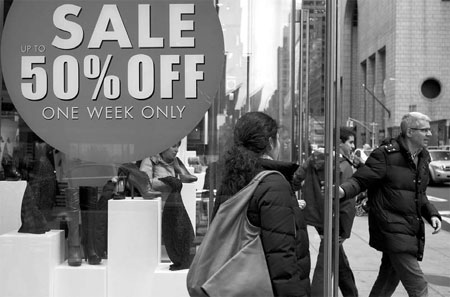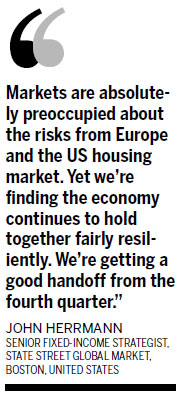US economy improving
Updated: 2012-01-09 07:07
By Shobhana Chandra and Rich Miller (China Daily)
|
||||||||
|
Pedestrians walking past a store advertising a sale in New York. Confidence among shoppers rose to an eight-month high in December as an improving job market helped Americans regain all the ground lost following the mid-year government budget battle and credit-rating downgrade. Scott Eells / Bloomberg |
|
|
WASHINGTON - The United States economy is beginning 2012 on a brighter note in a sign investors may be too pessimistic.
The number of people in jobs rose 200,000 in December, double the gain in November, a Labor Department report showed on Friday. A weekly measure of consumer confidence ended 2011 at a five-month high. Manufacturers reported their business in December grew at the fastest pace in six months. The combination indicates the world's largest economy has enough staying power to withstand a recession in Europe.
"Markets are absolutely preoccupied about the risks from Europe and the US housing market," said John Herrmann, senior fixed-income strategist at State Street Global Markets in Boston, and the second most-accurate US economic forecaster based on data from the last two years compiled by Bloomberg. "Yet we're finding the economy continues to hold together fairly resiliently. We're getting a good handoff from the fourth quarter."
Bob Doll, chief equity strategist at BlackRock Inc, the world's biggest asset manager, sees US stock prices rising and yields on Treasury securities climbing this year as investor concerns about the outlook abate.
"We don't need Europe to solve all its problems in 2012," he said in a Jan 5 note to clients. "Since there is already such a significant 'crisis premium' baked into the markets, just avoiding disaster could be enough."
Doll forecasts that US stocks will return at least 10 percent in 2012, beating foreign markets for a third year, as the nation's gross domestic product (GDP) expands by as much as 2.5 percent. GDP grew 1.8 percent last year, according to the median forecast of economists surveyed by Bloomberg News last month.
Unemployment rate
The December payrolls report capped four months of declines in the unemployment rate and six consecutive months of jobs gains of at least 100,000, indicating the labor market is gaining momentum heading into a presidential election campaign season that will be shaped largely by the state of the economy.
"We're starting to rebound," President Barack Obama said at the offices of the Consumer Financial Protection Bureau in Washington. He appealed to lawmakers to extend a payroll-tax cut through the rest of the year to ensure growth continues.
In the latest Gallup tracking poll conducted between Jan 3 and 5, 36 percent of Americans said the economy is getting better versus 59 who said it is worsening. As recently as Dec 1 to 3, 27 percent saw the economy improving against 69 percent seeing it worsening.
Obama's job approval also has been rising in recent months. The Gallup tracking poll showed Obama with a job approval rating of 45 percent between Jan 3 and 5 against monthly averages of 43 percent in December and November and a monthly average of 41 percent in each of the prior three months. The margin of error is plus or minus 3 percentage points.
Stocks and Treasury yields fell on Friday after William C. Dudley, president of the Federal Reserve Bank of New York, said the outlook for unemployment remains "unacceptably high" even though the jobless rate dropped to 8.5 percent, an almost three-year low. The Standard & Poor's 500 Index fell 0.3 percent to 1277.81 at the close in New York. The yield on the benchmark 10-year Treasury note fell to 1.96 percent from 2 percent on Jan 5.
At the close on Friday, the S&P index was valued at 13.5 times profits, about four points below the average price-to-earnings ratio since 1980, according to data compiled by Bloomberg.
Investors last year favored bonds over stocks, as they sought refuge from the financial turmoil in Europe. US Treasury securities returned 9.8 percent in 2011, their best annual performance since a 14 percent gain in 2008, according to Bank of America Merrill Lynch index data. Investors bought the US securities as a haven, with Europe's debt crisis threatening to infect the region's larger economies.
European economy
The damage to the US economy from the eurozone crisis has so far been smaller than forecast, Dominic Wilson, chief market economist for New York-based Goldman Sachs Group Inc, said in a Jan 4 report. Even so, he cautioned that it's too soon to sound the "all clear".
German factory orders dropped the most in almost three years in November, as the euro-region economy edged toward a recession and global demand weakened. Orders, adjusted for seasonal swings and inflation, slipped 4.8 percent from October, when they surged a revised 5 percent, the Economy Ministry in Berlin said in a statement on Jan 6.
In the US, export orders rose in December to the highest level in three months, according to manufacturer reports compiled by the Institute for Supply Management in Tempe, Arizona. Production and overall orders were the best since April.
US steel production reached 2.64 million metric tons in November, 19 percent more than a year earlier, according to the latest data from the Brussels-based World Steel Association. That's the highest single-month output since September 2008, according to data compiled by Bloomberg.
Steel inventories have remained low, "which suggests a realistic chance of an ongoing US real and apparent demand-led recovery in 2012", Credit Suisse Group AG analysts led by London-based Michael Shillaker wrote in a Jan 5 report.
The price of North American hot-rolled coil steel, an industry benchmark, has advanced 9.4 percent to $700 a ton since the final week of November, according to Steel Business Briefing. That compares with a 2 percent decline in European import prices to 485 euros ($618) a ton.
US Steel Corp, the largest US producer, will report net income of $367.5 million this year, compared with $24.7 million in 2011, according to the median of nine analyst estimates compiled by Bloomberg. Shares of the Pittsburgh-based company fell 55 percent last year, the worst performance since 2008. They will advance 10 percent to $31.39 in the next 12 months, based on the average of 14 analyst estimates.
Stepped-up consumption of steel is driven partly by improving car sales.
Bloomberg News

 Relief reaches isolated village
Relief reaches isolated village
 Rainfall poses new threats to quake-hit region
Rainfall poses new threats to quake-hit region
 Funerals begin for Boston bombing victims
Funerals begin for Boston bombing victims
 Quake takeaway from China's Air Force
Quake takeaway from China's Air Force
 Obama celebrates young inventors at science fair
Obama celebrates young inventors at science fair
 Earth Day marked around the world
Earth Day marked around the world
 Volunteer team helping students find sense of normalcy
Volunteer team helping students find sense of normalcy
 Ethnic groups quick to join rescue efforts
Ethnic groups quick to join rescue efforts
Most Viewed
Editor's Picks

|

|

|

|

|

|
Today's Top News
Health new priority for quake zone
Xi meets US top military officer
Japan's boats driven out of Diaoyu
China mulls online shopping legislation
Bird flu death toll rises to 22
Putin appoints new ambassador to China
Japanese ships blocked from Diaoyu Islands
Inspired by Guan, more Chinese pick up golf
US Weekly

|

|









